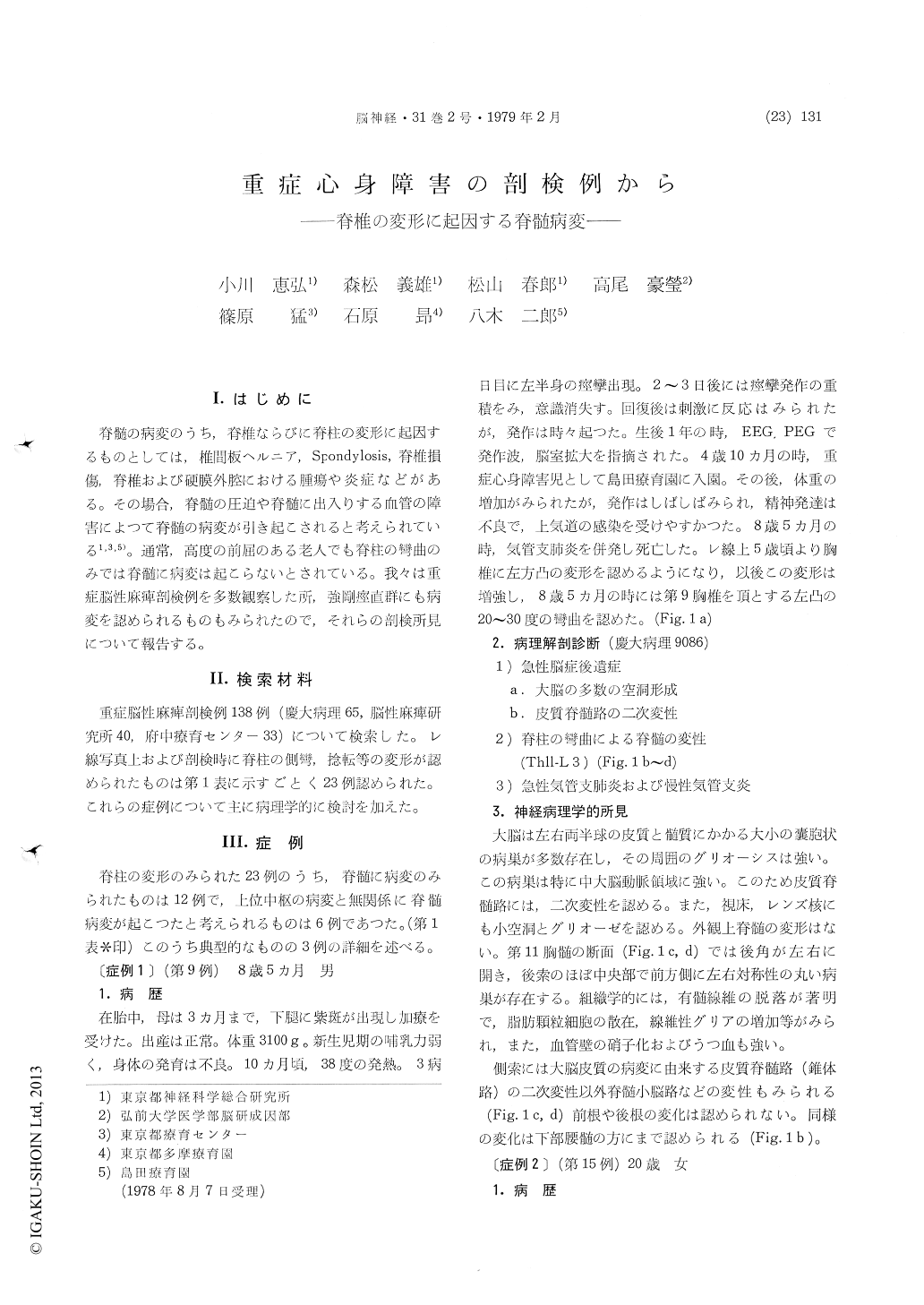Japanese
English
- 有料閲覧
- Abstract 文献概要
- 1ページ目 Look Inside
I.はじめに
脊髄の病変のうち,脊椎ならびに脊柱の変形に起因するものとしては,椎間板ヘルニア,Spondylosis,脊椎損傷,脊椎および硬膜外腔における腫瘍や炎症などがある。その場合,脊髄の圧迫や脊髄に出入りする血管の障害によつて脊髄の病変が引き起こされると考えられている1,3,5)。通常,高度の前屈のある老人でも脊柱の彎曲のみでは脊髄に病変は起こらないとされている。我々は重症脳性麻痺剖検例を多数観察した所,強剛痙直群にも病変を認められるものもみられたので,それらの剖検所見について報告する。
Out of 138 autopsy cases of severe cerebral palsy, spinal column deformities were found in 23 cases of which 12 cases were associated with spinal cord tract degeneration. The degenerative changes found in the posterior and lateral funiculi of 6 cases were unlikely to be secondary to upper center lesions and very marked in 3 cases. The posterior tract degeneration was localized in centro-median part of posterior one third of the tract. The lateral funiculi degeneration consisted of wedge shaped lesions based on the surface involving the spino-cerebellar and pyramidal tracts. In one case medianline was irregularly distorted associating with deformed H shaped grey matter. Two cases showed flattening of the posterior tract with displaced posterior longitudinal fissure. Histopathologically, most of lesions were composed of loss of myelinated fibers replaced by fibrous gliosis. Myelinated fibers were swollen in surrounding tissue. In the second case there was a focal area composing of spongy tissue with scattered macrophages close to old lesion in the lateral funiculus in one side and loss of nerve cells in the anterior and posterior horns could be seen. There were hyalinous change of blood vessels. Fibrous thickening of ligamentum denticulatum and meninges around lesions were also noted. Secondary degeneration of the spino-cerebellar and posterior tracts and that of the corticospinal tract were observed in the upper and lower levels respectively.
There was no definite spacial relation between spine deformity and spinal cord lesion. In the first case the pyramidal lesion was situated in L2 while top of curvature of the spine was at Th9.The second case had Th10 principal cord lesion and Th7 kyphosis. In the third case the principal cord lesion was in the Th6 and top of the primary spine curvature was at L2 and that of the secondary one was at the Th4. Deformity of the spinal cord may be resulted from deformed bony canal, over-stretched dura matter and thickened denticulate ligaments. There may be another factor responsible for lesion-formation that spinal column deformity occured in a stage of the development lost its harmony to the developing spinal cord. To dissolve the problem, however, in situ observation of the spinal cord with blood vessel in the spinal canal must be most important.
The posterior tract degeneration was situated within territory of the posterior spinal artery rather than boundary zone between two majors arterial supply. Venous origin may be considered account for wedge shaped lateral lesions. In general chronic ischemia due to disturbance of local micro-circulation must play a major role as pathogenesis.

Copyright © 1979, Igaku-Shoin Ltd. All rights reserved.


